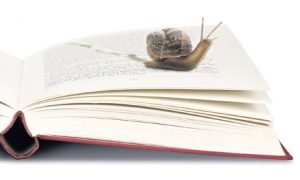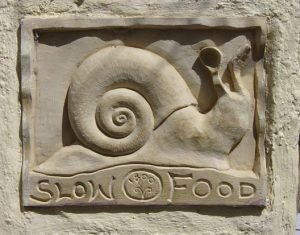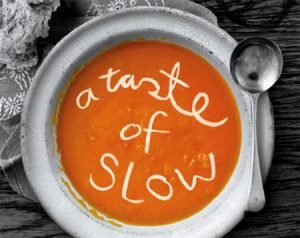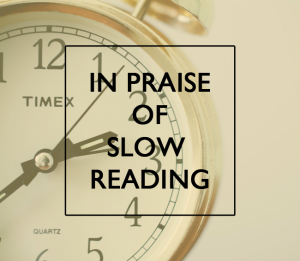 I have always thought of myself as being by nature a slow kind of person. I am, and always have been, slow in the morning to awaken to the day and slow in the evening to let go of it, though my habits are changing as I age. Various family members over the years have complained that I drive too slowly. I often seem to be the last one to finish eating (though sometimes I know this is because of eating more, not just more slowly). I am often quiet in group discussions because it takes me a while both to process what others are saying and to formulate words for my own thoughts. As a student I often found myself on essay tests looking around the room to see others busily writing while I had yet to put pen to paper and even after getting started could not physically produce a lot of words.
I have always thought of myself as being by nature a slow kind of person. I am, and always have been, slow in the morning to awaken to the day and slow in the evening to let go of it, though my habits are changing as I age. Various family members over the years have complained that I drive too slowly. I often seem to be the last one to finish eating (though sometimes I know this is because of eating more, not just more slowly). I am often quiet in group discussions because it takes me a while both to process what others are saying and to formulate words for my own thoughts. As a student I often found myself on essay tests looking around the room to see others busily writing while I had yet to put pen to paper and even after getting started could not physically produce a lot of words.
 Most often when I have thought of myself in these terms, it has been in a kind of a rueful spirit. I did well enough in school but probably would have done better had I not been constantly behind in my reading assignments and had my essay tests been less minimalist in nature. I was a minister in my working life, and there were many times when I wished it wouldn’t have taken me so long to produce a sermon. It would have increased my leisure time and reduced my level of stress. I would have been able to read so many more books in my lifetime if I had been a faster reader. But, regrettably, there are many areas of life where slow seems to be my way of being in the world.
Most often when I have thought of myself in these terms, it has been in a kind of a rueful spirit. I did well enough in school but probably would have done better had I not been constantly behind in my reading assignments and had my essay tests been less minimalist in nature. I was a minister in my working life, and there were many times when I wished it wouldn’t have taken me so long to produce a sermon. It would have increased my leisure time and reduced my level of stress. I would have been able to read so many more books in my lifetime if I had been a faster reader. But, regrettably, there are many areas of life where slow seems to be my way of being in the world.
 In recent years though I have been consoled by a growing number of voices who advocate “slow” approaches as a positive good. Of course there have always been advocates of resisting the frenetic pace of modern life. I think immediately of Thoreau, to name just one, who wrote when the “pace of modern life” was not nearly as frenetic as it is today. But the current “slow movement” can be traced to a protest in Rome in 1986 over plans to build a McDonald’s near the Spanish Steps, a popular tourist attraction. In the short term the protest failed. The McDonalds was built and remains in operation today. But that is only part of the story. Carlo Petrini, the organizer of the protest, went on to organize or inspire a number of “slow food” groups first in Italy, then throughout Europe and eventually internationally. As opposed to fast food, slow food advocates propose using locally grown, non-industrial (organic, non-GMO) food and preparing and sharing food slowly in a family or communal setting.
In recent years though I have been consoled by a growing number of voices who advocate “slow” approaches as a positive good. Of course there have always been advocates of resisting the frenetic pace of modern life. I think immediately of Thoreau, to name just one, who wrote when the “pace of modern life” was not nearly as frenetic as it is today. But the current “slow movement” can be traced to a protest in Rome in 1986 over plans to build a McDonald’s near the Spanish Steps, a popular tourist attraction. In the short term the protest failed. The McDonalds was built and remains in operation today. But that is only part of the story. Carlo Petrini, the organizer of the protest, went on to organize or inspire a number of “slow food” groups first in Italy, then throughout Europe and eventually internationally. As opposed to fast food, slow food advocates propose using locally grown, non-industrial (organic, non-GMO) food and preparing and sharing food slowly in a family or communal setting.
 In 1989 the first international meeting of slow food groups produced a “Slow Food Manifesto” which read in part: “We are enslaved by speed and have all succumbed to the same insidious virus, Fast Life, which disrupts our habits, pervades the privacy of our homes and forces us to eat Fast Foods… A firm defense of quiet material pleasure is the only way to oppose the universal folly of Fast Life… Our defense should begin at the table with Slow Food. Let us rediscover the flavors and savors of regional cooking and banish the degrading effects of Fast Food.” Clearly the slow food movement was, and is, not just about food. It is rooted in a more general world view that values speed and its attendant qualities less and slowness and its attendant qualities more.
In 1989 the first international meeting of slow food groups produced a “Slow Food Manifesto” which read in part: “We are enslaved by speed and have all succumbed to the same insidious virus, Fast Life, which disrupts our habits, pervades the privacy of our homes and forces us to eat Fast Foods… A firm defense of quiet material pleasure is the only way to oppose the universal folly of Fast Life… Our defense should begin at the table with Slow Food. Let us rediscover the flavors and savors of regional cooking and banish the degrading effects of Fast Food.” Clearly the slow food movement was, and is, not just about food. It is rooted in a more general world view that values speed and its attendant qualities less and slowness and its attendant qualities more.
Thus over the past thirty years there have come to be other notions and movements similar to, and perhaps based on, slow food. Nowadays you will find Wikipedia entries on such things as Slow Cities, Slow Design, Slow Work, Slow Travel, Slow Money, Slow Parenting, Slow Medicine, and Slow Church. I won’t try to elaborate on the various concepts; in some cases it is probably easy enough to guess what might be involved. But one that I didn’t include in the list above, and that I want to lift up in this context, is Slow Reading.
 There is a practice in Christianity known as Lectio Divina, divine or sacred reading. It is a way of approaching scripture not intellectually or analytically but reverentially. It requires slow reading, perhaps out loud. It combines the reading of the text with meditation and contemplation. It stops to consider prayerfully how the text not so much teaches but touches the person who is reading it. It ends by inviting the reader to dwell in communion with the spirit of God as it reaches you through the spirit of the text.
There is a practice in Christianity known as Lectio Divina, divine or sacred reading. It is a way of approaching scripture not intellectually or analytically but reverentially. It requires slow reading, perhaps out loud. It combines the reading of the text with meditation and contemplation. It stops to consider prayerfully how the text not so much teaches but touches the person who is reading it. It ends by inviting the reader to dwell in communion with the spirit of God as it reaches you through the spirit of the text.
There are these days, so I understand, book clubs that promote slow reading, either by reading pieces out loud to each other or perhaps by reading a book one chapter or section at a time. I’m for it. Nothing wrong with getting away from trying to locate this month’s selection at the last minute and trying to read most of it by Tuesday at 7:30. And I have come to realize that my slow reading is not necessarily a disability or a disadvantage. There are both pleasures and virtues in slow reading per se, though there are still enough times when I wish I had the ability to speed through something for a limited purpose.
Still there is more at stake for me than the occasional pleasures and appreciations of reading at a relaxed pace. When I pick up a novel, there is almost always a hope tucked away in my consciousness that this piece of writing will become a kind of a sacred text for me. There is a hope that I will find I cannot read it other than prayerfully. There is a hope that I will be slowed by my eyes watering and blurring my vision. There is a hope that when I am done I will not be able to move on quickly to something else because I need to dwell for a while in the world that has been created.
I know that for many people reading this I do not need to defend the practice of slow reading. I have no desire to argue the matter in any case, just to offer a few words of praise.
–Jim Bundy
The author of an historical study, and a collection of sermons, Jim Bundy is a retired minister living in Charlottesville, VA.
Follow us!
Share this post with your friends.

